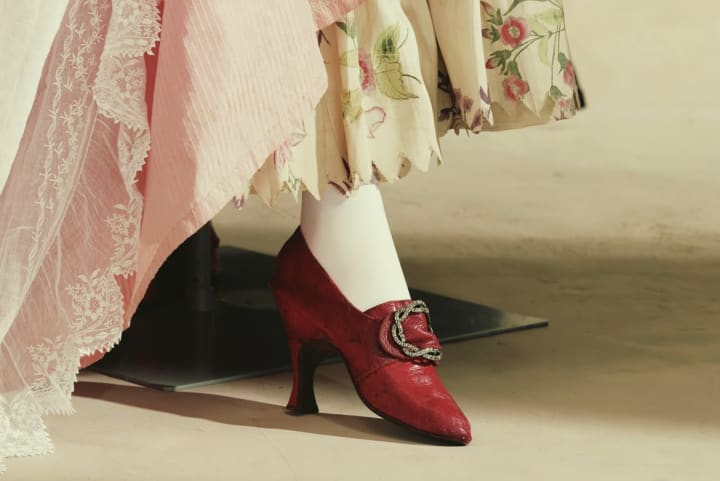Origin of the High Heel Trend: High Heel as a Symbol of Masculinity
What Stopped Men From Wearing High Heels

When I think of Stilettos, the first words that come to mind are sexy, power, femineity. High heels have been prominently associated with female traits and fashion, a strong representation of female empowerment and physical attractiveness. We see them mostly worn by women everywhere at formal events— clubs, parties, date outings, and the like. So, when we spot a man wearing high platforms or any sort of high-heeled footwear, we automatically throw at them the feminine label. What’s tremendously ironic is that history tells a rather contrary story. Do you know men began the high heel trend decades ago and wore them to display their virility and masculinity?
I was having issues with my Arabian husband over my penchant for wearing high-heeled ankle boots on our date outings. One would think his distaste stemmed from my appearing taller than him, but even in high heels, I was shorter than him. He despised my 3-inch heel faux suede boots, particularly, because of the clicking sound they made. He had said the supermodel gait they gave off and the clicking sound altogether were sensual and caught men’s attention. I went home that day, frustrated about whether I should give up wearing heels with my husband during our date outings, and surfed the internet over high heels and female sexuality.
And oh boy, was he wrong.
The Early Use of High Heels
The truth is high-heeled shoes were first invented as a symbol of masculinity and not femineity decades ago in Western Asia during the medieval period. High heels were made for and worn exclusively by men, the first origin of them appearing in Ancient Egypt. According to footwear historian Elizabeth Semmelhack, a senior curator at the Bata Shoe Museum in Toronto, Persian soldiers used high heels as a great war asset to exert military prowess and skilled horsemanship in the 10th century. Persian soldiers rode in high-heeled shoes over their horses, using them to hold their balance on the stirrups. The high heels gave them steadiness on their horses and helped them fight more efficiently and skillfully. So, Come again? Who said high heels have no practical use?

High Heels Used as a Fashion Statement by Aristocrat Men
But men only began to use high heels as a fashion statement and for aesthetic purposes in the 17th century. The resurgence of high heels in the 17th century in Europe saw high heels as a symbol of fashion style and high social status, mainly used by aristocratic men. In 1599, Abbas the Great, a Persian ruler who made commercial agreements with Western Europe to help him defeat the ottoman empire, dispatched a Persian diplomat to Germany, Russia, and Spain. This caused the widespread of Persian culture, including the birth of the high heel trend in Europe. High heels went from being a practical instrument for Persian cavalry to becoming a voguish sensation in European fashion.
Macho European aristocrats wore high-heeled shoes to flaunt their wealth and to acquire a formidable, masculine figure. Ornamented high heels, ranging from 1 to five inches tall, became a popular phenomenon in Paris and widely used by aristocrat men as a symbol of privilege. Charles II's cousin, Louis XIV of France, is pictured wearing red high heels in a 1701 portrait by Hyacinthe Rigaud.

In Western European fashion, high heels were designed to emphasize the rift between the working people and the aristocracy during the 17th century. When high-heeled shoes reached the working men and women, the aristocrats didn’t want to be associated with the lower ranks. So, they increased the heel height to emphasize social class distinctions. Aristocrat high heels tended to be made from fine fabrics and decorated with rosettes, ribbons, or buckles. They mostly wore red heels to represent their privilege, as the red dye was highly expensive in the 17th century. In fact, Louis XIV issued an order that only the aristocracy had the privilege to wear red heels in the 1670s. That’s why it’s very common to see aristocrats like Louis XIV wearing red heels.

The high heel above belonged to a well-to-do boy. This is evident from the height of the heel, the ribbon, and the red painting on the heel which signifies his wealth.
Women Adopting High Heel Fashion to Masculinize Wardrobe
So, how did such a powerful object that exuded masculinity and male empowerment be associated with femineity, and mainly women? The first record of a woman wearing high heels is in the 16th century, worn by Catherine de Medici to appear taller in her wedding. According to Semmelhack, the high heel appeal among women became more prevalent in the early 17th century when women began adopting men's fashion in their wardrobe to masculinize their appearances. Wow, that’s quite the irony since my husband had asserted my high-heeled boots had a sensual, feminine aura about them. Women incorporated the high-heel look with what was mostly associated with male fashion— short hair, masculine hats, epaulets, and clay tobacco pipes.
The evolution of high heels to femineity doesn’t get any better. As both genders started to embrace the high heel trend near the end of the 17th century and wore high heels simultaneously, heel form transformations based on gender distinctions were put in place. Men’s heel style were more robust and had lower thick heels like clog sandals whereas women’s heels were narrower and slender.

The Emergence of the Enlightenment and Practical Men Fashion
The Enlightenment period in Europe during the 18th century, which emphasized rationality, practicality, and social equality over superstition, resented high heels for its mere impracticality. The Enlightenment's practical approach to fashion brought about a significant shift in European fashion, causing many aristocrat men to cast off their vibrant costumes and extravagant wardrobes and move towards comfort clothing. This included practical footwear like flat shoes.

Because the Enlightenment advocated for liberty and human rights, high heels were no longer a symbol of privilege and wealth. But rather a symbol of foolishness and the irrational, which men associated mostly with women during that period. High heels were soon singled out as feminine footwear. The Enlightenment period subjugated women and confined them to social norms that viewed them as irrational and sentimental creatures. This explains why women still clung to high heels during that time and weren’t reprimanded for it.

Click clock, click clock. My 3-inch heel boots hit the sidewalk as I walk alongside my husband to The Cheesecake Factory. Does he look annoyed? I don’t know. But what I do know is he is familiar now with the history of the high heel trend and its everchanging symbolism. There is nothing inherently wrong with women adoring high heels and viewing them as a fashion statement in their wardrobe. It’s just interesting to know how an object can acquire different meanings and symbols through generations.
Works-Cited
De Araújo Ferreira, Fernanda. Unraveling the high heel. Diss. Massachusetts Institute of Technology, 2020.
Kremer, William. "Why did men stop wearing high heels?" BBC World Service, 25 Jan. 2013. Web. 14 Mar. 2021 https://www.bbc.com/news/magazine-21151350
Copyright © 2017 Bata Shoe Museum, Toronto, Canada https://batashoemuseum.ca/image-permissions/
Royal Collection. High Heels Fit for a King. Charles II: Art & Power: The Queen's Gallery, Buckingham https://www.rct.uk/collection/themes/exhibitions/charles-ii-art-power/the-queens-gallery-buckingham-palace/high-heels-fit-for-a-king







Comments
There are no comments for this story
Be the first to respond and start the conversation.